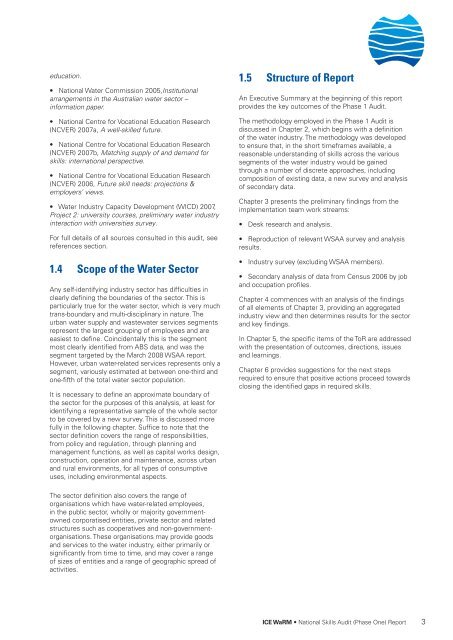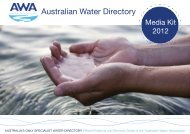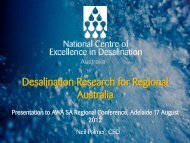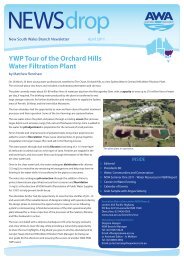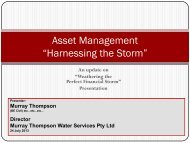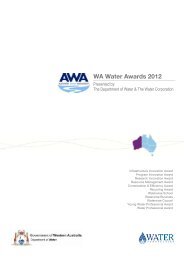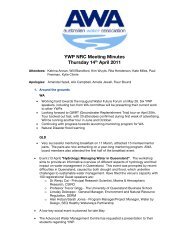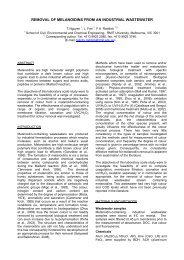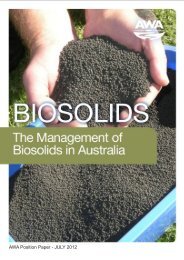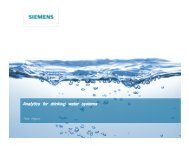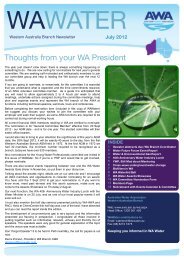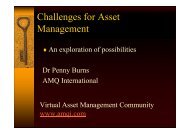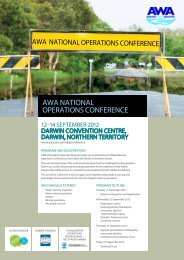National Water Skills Audit - Australian Water Association
National Water Skills Audit - Australian Water Association
National Water Skills Audit - Australian Water Association
- No tags were found...
Create successful ePaper yourself
Turn your PDF publications into a flip-book with our unique Google optimized e-Paper software.
education.• <strong>National</strong> <strong>Water</strong> Commission 2005,Institutionalarrangements in the <strong>Australian</strong> water sector –information paper.• <strong>National</strong> Centre for Vocational Education Research(NCVER) 2007a, A well-skilled future.• <strong>National</strong> Centre for Vocational Education Research(NCVER) 2007b, Matching supply of and demand forskills: international perspective.• <strong>National</strong> Centre for Vocational Education Research(NCVER) 2006, Future skill needs: projections &employers’ views.• <strong>Water</strong> Industry Capacity Development (WICD) 2007,Project 2: university courses, preliminary water industryinteraction with universities survey.For full details of all sources consulted in this audit, seereferences section.1.4 Scope of the <strong>Water</strong> SectorAny self-identifying industry sector has difficulties inclearly defining the boundaries of the sector. This isparticularly true for the water sector, which is very muchtrans-boundary and multi-disciplinary in nature. Theurban water supply and wastewater services segmentsrepresent the largest grouping of employees and areeasiest to define. Coincidentally this is the segmentmost clearly identified from ABS data, and was thesegment targeted by the March 2008 WSAA report.However, urban water-related services represents only asegment, variously estimated at between one-third andone-fifth of the total water sector population.It is necessary to define an approximate boundary ofthe sector for the purposes of this analysis, at least foridentifying a representative sample of the whole sectorto be covered by a new survey. This is discussed morefully in the following chapter. Suffice to note that thesector definition covers the range of responsibilities,from policy and regulation, through planning andmanagement functions, as well as capital works design,construction, operation and maintenance, across urbanand rural environments, for all types of consumptiveuses, including environmental aspects.1.5 Structure of ReportAn Executive Summary at the beginning of this reportprovides the key outcomes of the Phase 1 <strong>Audit</strong>.The methodology employed in the Phase 1 <strong>Audit</strong> isdiscussed in Chapter 2, which begins with a definitionof the water industry. The methodology was developedto ensure that, in the short timeframes available, areasonable understanding of skills across the varioussegments of the water industry would be gainedthrough a number of discrete approaches, includingcomposition of existing data, a new survey and analysisof secondary data.Chapter 3 presents the preliminary findings from theimplementation team work streams:• Desk research and analysis.• Reproduction of relevant WSAA survey and analysisresults.• Industry survey (excluding WSAA members).• Secondary analysis of data from Census 2006 by joband occupation profiles.Chapter 4 commences with an analysis of the findingsof all elements of Chapter 3, providing an aggregatedindustry view and then determines results for the sectorand key findings.In Chapter 5, the specific items of the ToR are addressedwith the presentation of outcomes, directions, issuesand learnings.Chapter 6 provides suggestions for the next stepsrequired to ensure that positive actions proceed towardsclosing the identified gaps in required skills.The sector definition also covers the range oforganisations which have water-related employees,in the public sector, wholly or majority governmentownedcorporatised entities, private sector and relatedstructures such as cooperatives and non-governmentorganisations.These organisations may provide goodsand services to the water industry, either primarily orsignificantly from time to time, and may cover a rangeof sizes of entities and a range of geographic spread ofactivities.ICE WaRM • <strong>National</strong> <strong>Skills</strong> <strong>Audit</strong> (Phase One) Report


